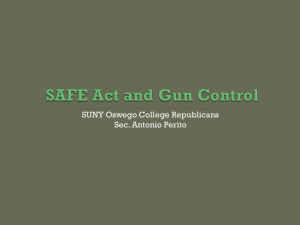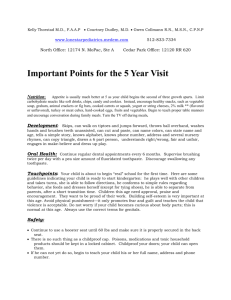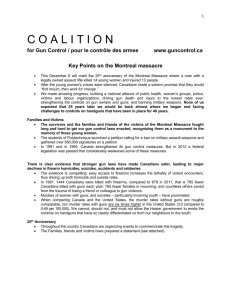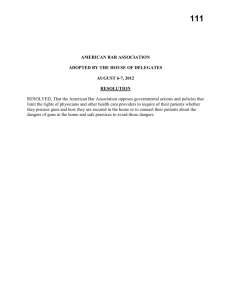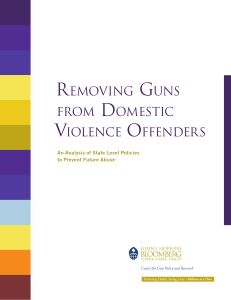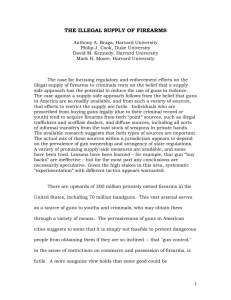Waymon Chung Unit II America is very well known for its second
advertisement
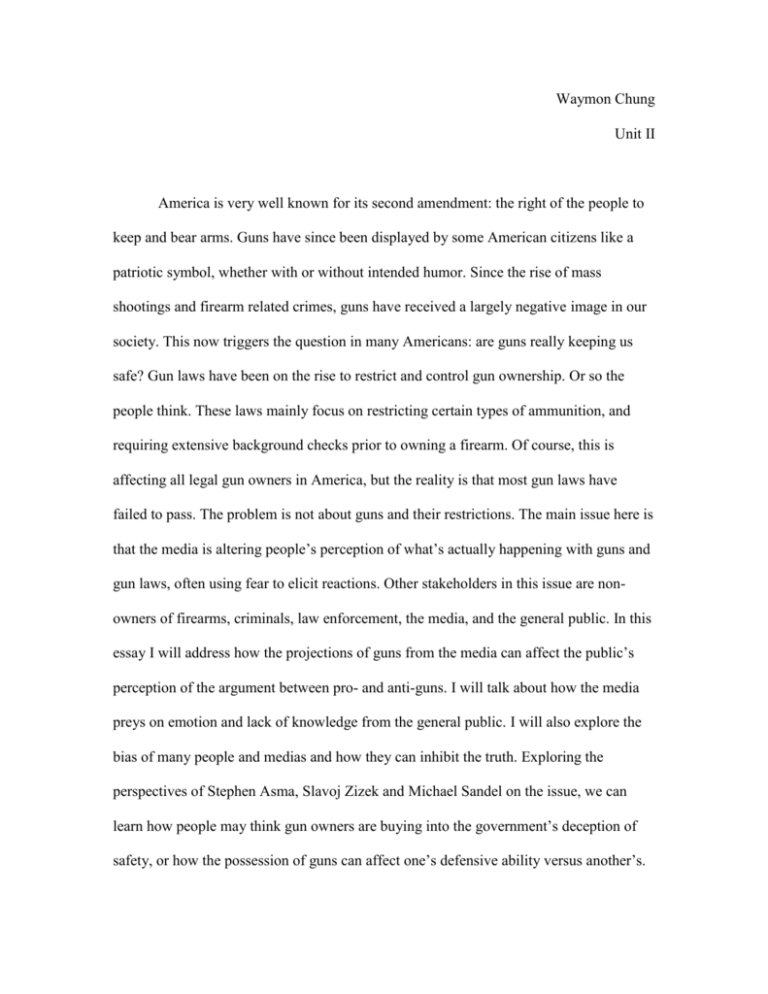
Waymon Chung Unit II America is very well known for its second amendment: the right of the people to keep and bear arms. Guns have since been displayed by some American citizens like a patriotic symbol, whether with or without intended humor. Since the rise of mass shootings and firearm related crimes, guns have received a largely negative image in our society. This now triggers the question in many Americans: are guns really keeping us safe? Gun laws have been on the rise to restrict and control gun ownership. Or so the people think. These laws mainly focus on restricting certain types of ammunition, and requiring extensive background checks prior to owning a firearm. Of course, this is affecting all legal gun owners in America, but the reality is that most gun laws have failed to pass. The problem is not about guns and their restrictions. The main issue here is that the media is altering people’s perception of what’s actually happening with guns and gun laws, often using fear to elicit reactions. Other stakeholders in this issue are nonowners of firearms, criminals, law enforcement, the media, and the general public. In this essay I will address how the projections of guns from the media can affect the public’s perception of the argument between pro- and anti-guns. I will talk about how the media preys on emotion and lack of knowledge from the general public. I will also explore the bias of many people and medias and how they can inhibit the truth. Exploring the perspectives of Stephen Asma, Slavoj Zizek and Michael Sandel on the issue, we can learn how people may think gun owners are buying into the government’s deception of safety, or how the possession of guns can affect one’s defensive ability versus another’s. Firearms were originally granted by law as a tool for self-defense, especially in one’s home. People saw firearms as a sign of safety and protection. In the modern world, firearms have been portrayed by the media as an offensive weapon commonly linked to murder and crime. Many argue that it’s not the guns that are killing people, but it is that people are killing people. To counter this, laws have restricted the ownership of firearms to persons who voluntarily seek medical assistance for any mental health problems. Even then, if all guns were out of the picture, some people believe that the murderers would still find alternate ways of murder. All while many other Americans fear that guns play a large role in mass murders, especially due to a firearm’s ease of use compared to lethality. Pro-gun Americans often argue that the criminals will always have access to guns, even if they were illegal. Michael Sandel would argue that increasing the circulation of guns for legal owners would not bring justice to said criminals, but may elicit other problems with the law, depending on the situation. Now the issue becomes: how does an unarmed American defend himself against an armed criminal with intent to use deadly force? A common saying that many have come across is that when seconds count, police are only minutes away. Law enforcement will not always be there to save the day, especially if the threat is blocking the access to contacting law enforcement. There are numerous cases of home invasions that end up with the owner killing the invader with a firearm. Stephen Asma would argue that protecting your family is a priority in this case and saving the intruder would be only secondary. Michael Sandel would input the fact that if the invader had a gun, then it would be justified for the owner to shoot first. If the invader had simply entered the home unarmed even with the intention of crime, Sandel would argue that the owner with the gun would be at an advantage and should not shoot the intruder unless confronted with an imminent threat. This firearm advantage is what attracts gun owners to using firearms as means of self and home defense. This advantage also becomes a problem when there is no set limit to what is considered adequate for defense. Although rifles and shotguns aren’t normally seen as threatening because they are associated with hunting instead of crime, they are becoming a popular target for media to pick on. Recent firearm laws have restricted magazine capacity and certain accessories for civilian use. This did not change how the media advertises them. A common term seen used by the media is “assault rifle.” It is a term that is also frequently used outside of its original definition. An assault rifle is a rifle with capabilities for selective fire, including fully automatic firing mode. For civilians to own an assault rifle they would have to go through very extensive paperwork and background checks, and they are only available in limited states. Often when used in media discussions, “assault rifle” actually refers to tactical- or military-looking firearms, as if looks could kill. Despite the misuse of definition, the media persistently uses terms like this to induce fear into the general public. Because certain aspect of firearms are not common knowledge to the general public, the media is able to influence some people’s perspective on firearms. Because of this, Zizek would argue that the media is not the source of the problem, but it is the people. Sandel would agree to that it is not a fair argument if not both sides are educated on the subject. As Zizek would say, the argument between pro- and anti-gun is not the issue, and the problem would not be solved by eliminating media influence, but rather by reframing how information educates the general public. By providing reliable information to the people’s knowledge, Sandel would note that the educated mind would be able to see that the root of the argument does not stem from two different sides, but rather from the nature of fear from both parties. Like Sandel, Zizek agrees that an educated mind would be better at seeing the root of the argument, but instead of it being the nature of fear, Zizek would say that it would be from the desire for comfort. Both parties find comfort in arguing for what they believe, because they fear that the other party will compromise their access to comfort. Whether guns can be determined good or bad, the truth is that they have been used to both save lives and take lives. Between the two sides of the argument, a stubborn bias can be just as influential as the predatory media. Michael Sandel would propose that the nature of the argument would lead to a necessity to suppress the disagreement, which would prevent mutual respect to be reached. Both parties are fighting for the safety and concern for their families. Their bias on the situation inhibits the truth that they are not actually fighting each other, but rather the true enemies are the criminals and murderers. The media contributes to this misconception by framing the blame on firearms and all its owners. Because mass murder shootings are such a catastrophic event that happens so suddenly, they can trigger rapid escalation in fear. In truth, firearms only accounted for 1.2% of deaths in the United States in 2011. (Wadman, 2013) While any percentage of death is undesirable, it is important to see that the source of the problem is not only from gun ownership, but from multiple related sources as well. To revisit the issue, the media is altering people’s perception on the current situation with firearms in today’s society. The problem is that it is skewing the truth by taking advantage of the general public’s limited knowledge and forcing negative opinions on them. Whether it can be argued that guns are either good or bad for society, the real issue is the fear that is caused by how people and media portray firearms. This is significant because if the general public actively fears firearms, it could end up limiting the use of firearms for personal protection in areas where it is necessary. As mentioned before, criminals will always have access to guns even when the law does not allow it. The question becomes, which do you fear more: guns, or criminals with guns? Works Cited Asma, Stephen T. “The Myth of Universal Love.” Evolving Ideas 2014-2015 Edition. Ed. University College. Plymouth: Hayden-McNeil, 2014. 12-16. Print. Sandel, Michael. “The Lost Art of the Democratic Debate.” Ted. Ted, Feb. 2010. Web. 5 Oct. 2014. Wadman, Meredith. “The Gun Fighter.” Nature 496.7446 (2013): 412-415. Academic Search Complete. Web. 10 Dec. 2014. Zizek, Slavoj. “First as Tragedy, Then as Farce.” YouTube. YouTube, 10 Mar. 2010. Web. 5 Oct. 2014.

